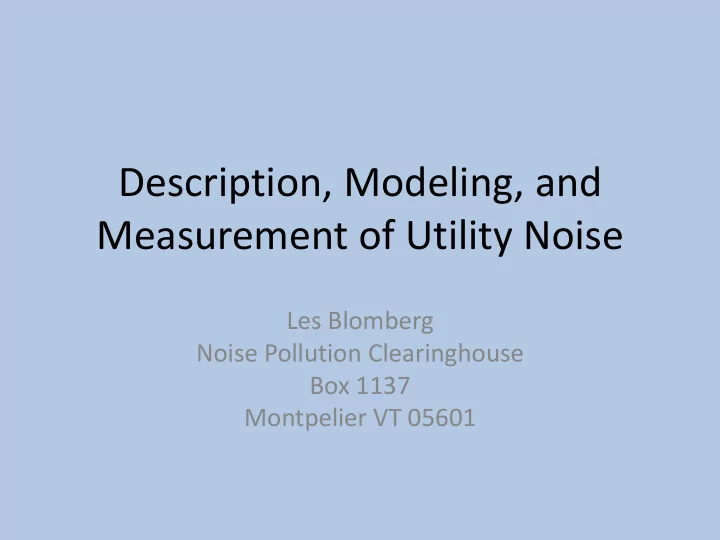

Description, Modeling, and Measurement of Utility Noise Les Blomberg Noise Pollution Clearinghouse Box 1137 Montpelier VT 05601
Board’s Order • A sound "primer" on such topics as how sound is described, modeled, and measured. – Metric – Modeling – Monitoring • Merits of, and approaches to, potential development of a review of scientific and technical literature regarding sound impacts from energy facilities
The Challenge in Developing a Metric, Criteria, and Monitoring Plan Metrics and Metrics and Criteria Criteria Used in Usable in Compliance Scientific Research or Enforcement Lden Ldn See Lmax Lnight Presentation Leq(1) Leq(24) Yearly Average
Outline • Lessons Learned from Previous Utility Cases • Better Monitoring Options • When Do Noise Problems Occur • 21 st Century Noise Monitoring • Not in Presentation – Low Frequency
Lessons Learned 1. Current monitoring is expensive and inconclusive “…it is unlikely … that the results obtained in this survey – actually quantify the project-only sound” (Vermont Wind, 1 St Quarterly Report, Executive Summary) “A slightly higher level at the exposed primary position – than at the shielded position only 75 ft. away could well be just a matter of greater exposure to tree rustle, birds or far off ambient sounds.” (Vermont Wind, 1 St Quarterly Report, 19) “an unequivocal determination of the project-only – sound level, exclusive of any background contamination, is not possible “(Vermont Wind, 1 St Quarterly Report, 27)
Lessons Learned 2. Without turning the turbines off, determining turbine levels is difficult to impossible. – 1 hour averages means data has lots of opportunities for contamination • Very little useable data – Don’t know if the site 2 miles away has the same background as house – Source contamination behind house
Lessons Learned 3. Need to take the accuracy of modeling into account when considering noise predictions ISO 9613 (basis for modeling) has a 3 dB error – Wind turbines exceed the height for the standard •
Lessons Learned 3. Need to take the accuracy of modeling into account when considering noise predictions Concawe has an even larger error – Concawe, 28
Lessons Learned 3. Need to take the accuracy of modeling into account when considering noise predictions CADNA on error – DataKustik Technical Note, 4
Lessons Learned 4. Inside turbine noise levels are not much less than outside when windows are opened – ASTM E966 – Can’t extrapolate from one house to another
Lessons Learned 5. Lack of an Aesthetics (Act 250 Criterion 8) standard is responsible for much of the noise problem People are complaining about hearing the noise – in their homes Need to account for quiet backgrounds in many – communities, especially at night In Act 250, noise is most often addressed under – Criterion 8
Lessons Learned 6. Needing NRO mode means the turbines are too big Turbines size is the most effective noise control – NRO less effective in ridge top/high wind shear – locations NRO requires constant monitoring to – Trigger NRO • To ensure compliance • Assess the effectiveness of NRO in ridge top settings •
Lessons Learned 7. Microphone location is critical Creeks, vegetation, roads create contamination – Incomplete screening of background location – Partial screening at source site – Need a collaborative process to select – microphone locations
Better Monitoring Options 1. Shorter time periods Lmax – Leq(1 min) – Act 250 uses Lmax –
Better Monitoring Options 2. Distance is a surrogate for noise Not sufficient alone – Cheap and easy – Depends on turbine size –
Better Monitoring Options 3. ANSI S12 100 Upward masking – Most human caused noise is < 1,000 Hz – Filters potential contaminating sounds > 1,000 Hz – Leaf-rustle • Peaks at 2,000 to 3,150 HZ – Insects • 8,000 Hz –
Better Monitoring Options 3. ANSI S12 100
Better Monitoring Options 4. Audibility Audibility most popular addition to noise – regulations in last 20 years Cheap • Effective • NYC, Burlington, Montpelier, Woodstock, – Morristown, Wallingford, Fair Haven, … No audible noise in non-participating homes – Correlates well with what people complain about –
Better Monitoring Options 4. Audibility – “Plainly audible means any sound that can be detected by a person using his or her unaided hearing faculties. As an example, if the sound source under investigation is a portable or personal vehicular sound amplification or reproduction device, the enforcement officer need not determine the title of a song, specific words, or the artist performing the song. The detection of the rhythmic base component of the music is sufficient to constitute a plainly audible sound.” Williston Noise Ord.
21 st Century Noise Monitoring 1. Real-time web-based data sharing Noise monitoring – Power production – Meteorological conditions – – Increase trust and openness – Increase compliance
Crafting Usable Metrics and Criteria for Compliance that Approximate those Used in the Scientific Literature Metrics and Metrics and Criteria Criteria Used in Usable in Scientific Research Enforcement or Compliance Short time periods Distance S12 100 Audibility
Don’t Forget • Error • Aesthetics criteria • NRO noise control limitations • Inside measurements • Microphone location
Recommend
More recommend